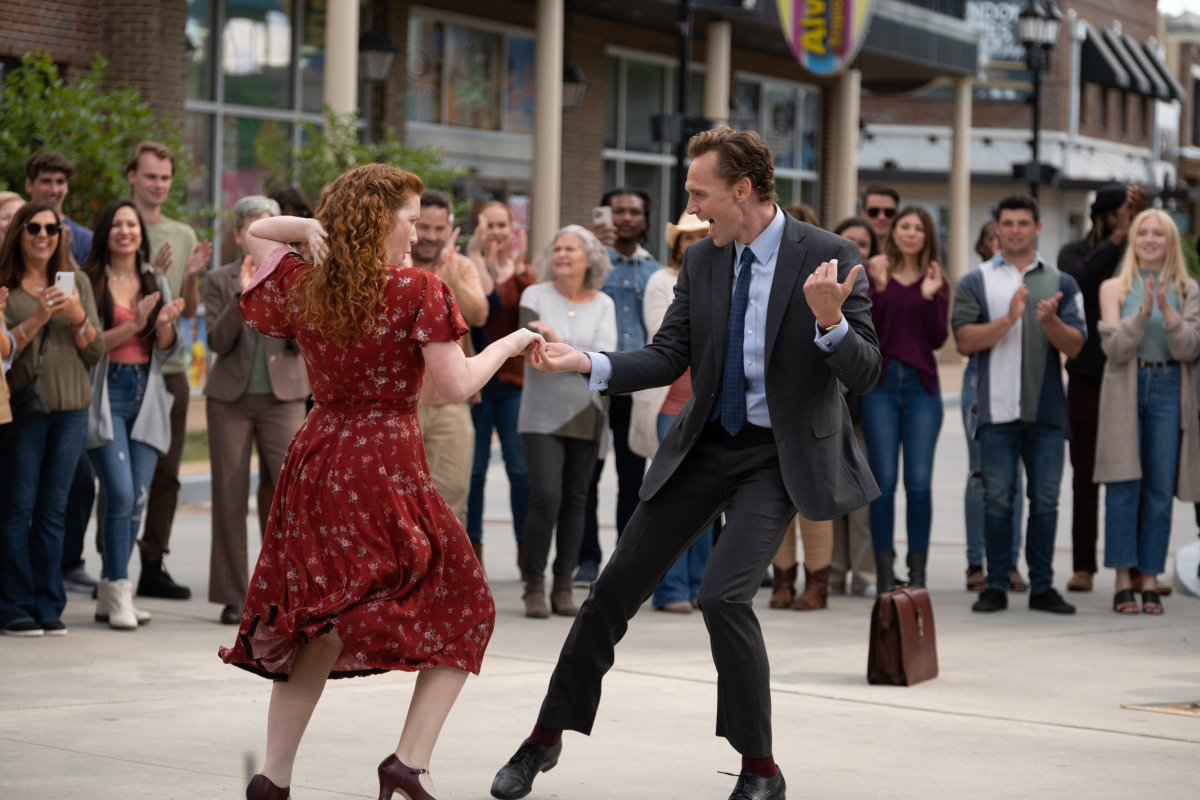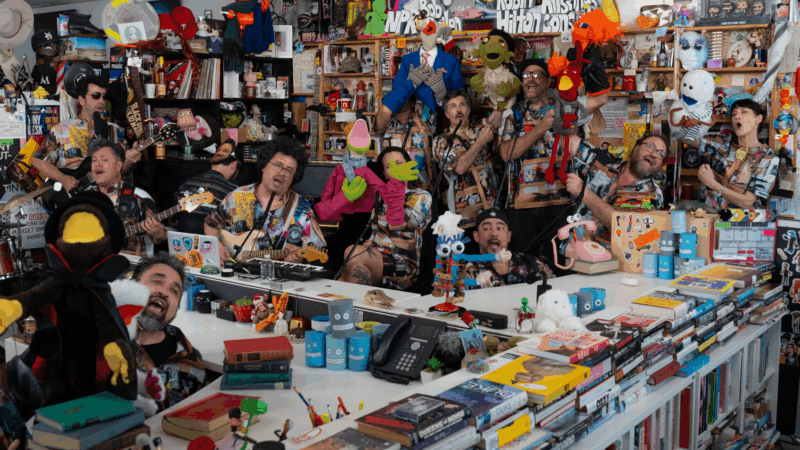We’re all going to die. What now? ‘The Life of Chuck’ sits with this question

One way to think about Stephen King is that he writes two kinds of stories: colds and warms. The colds are the unrelenting horrors, bloody and brutal, like The Shining, It, Carrie, Cujo, or The Stand. The warms are the stories of connection and hope, most famously The Body and Rita Hayworth and Shawshank Redemption, which were adapted into the films Stand By Me and (obviously) The Shawshank Redemption. Under this analysis, the novella The Life of Chuck, newly adapted into a film starring Tom Hiddleston, would be considered among the warms, on the side that gets called “life-affirming” and “uplifting.”
This isn’t right, though. Stephen King is preoccupied with monsters, dangers, tragedies and traumas – supernatural and not. And that’s true no matter what he’s writing. Like a lot of horror creators, he can never stop thinking about the worst things that could happen in a given moment. The Body is not just about teenagers who go searching for a dead kid; it’s about four friends who cannot know that only one of them will live to middle age. Rita Hayworth and Shawshank Redemption is about hope, certainly, but it is also about the effects of decades of brutal captivity, and about crushing corruption and institutional violence that cannot be cured, only outlasted or escaped.
If there’s a useful rough division of King’s stories, it’s between the ones that describe a world of horrors on one hand, and the ones that consider what to do about being in a world of horrors on the other. This isn’t a clean distinction, certainly, nor does it map cleanly to downbeat versus upbeat — sometimes the straight-up horrors are told with dark humor, as in “Survivor Type,” a gnarly little short story about a doctor who gets marooned on a desert island and starts eating himself. A King story usually has an element of warning. This could happen to you, says Stephen King, as the doctor eats his foot, or as a finger comes up out of a bathroom drain, or as a haunted car or a pandemic or a vampire or a rabid dog appears. This could happen to you.
But many of his stories have a paradox at their cores. He believes in menace and evil, and in the brutality of a world that kills kids, and helpless people, and good people. He is not a horror writer who punishes the foolish above others.
At the same time, he writes with a deeply humane central thesis, which is that in light of all those monsters, you are blessed to have in your life at least your own resilience and the company of other people. The Stand is not really about the flu, after all; it is about creating a new community and choosing to make sacrifices for it. It is only superficially about the clown. Really, it’s about fear and trauma, and especially about strength in numbers. These are what you might call the “What now?” stories: You know the world is full of pain … what now? The worst has happened … what now? You are fully aware of your own mortality … what now?

The Life of Chuck, as adapted and directed by Mike Flanagan (of Netflix’s The Haunting of Hill House), begins with a depiction of a dwindling world that’s easy to identify as King’s. And indeed, the film stays very close to the novella, down to dialogue and details. In the first act, a teacher named Marty (Chiwetel Ejiofor) is baffled as the world around him seems to be ending. At the same time, a billboard appears in town with a photo of a man he’s never seen before, sitting behind a desk, accompanied by the words, “Thanks, Chuck! For 39 Great Years.” As Marty and his ex-wife (Karen Gillan) talk on the phone about the cascading disasters that have knocked California into the sea, set off a volcano in Germany, and taken down the entire internet, they wonder why on television, on the radio, and on advertising around town, they keep getting these messages about Chuck, who they figure is retiring from some office job.
His connection to the end of the world should not be spoiled, but in the second act, we will learn that Chuck is Chuck Krantz, played as an adult by Tom Hiddleston, a married accountant who’s quite a good dancer. Chuck has had a hard life: His parents died when he was little, and he was raised by his grandparents, who are played by Mark Hamill and a positively radiant Mia Sara. His great joy, encouraged by his grandmother, is dancing, and in the film’s most widely promoted sequence, he spends a magical (and wholesome) afternoon dancing with a young woman who’s just been dumped by her boyfriend, accompanied by a busking drummer.
We spend time with middle-aged Chuck, and in the third act with young Chuck, as he tries to sort through his many pains. Losing his parents is one, but there is also the fact that the grandfather he adores is convinced that the cupola in their Victorian house is haunted, and that Chuck must never go up there to this padlocked room, ever, because it’s full of ghosts.
And what are ghosts, really, but reminders of the approach of death? Yours, mine, everyone’s? This is the Stephen King “What now?” story hiding in a film that can be promoted with dance sequences. One day, we will all be ghosts. We know this. What now? “Being sharply aware of your mortality is kind of a mixed bag” sounds glib and obvious, but it’s also profound and true, and it’s really what The Life of Chuck is about. It’s also a perfect fit for Flanagan, whose horror also usually has a poignant note of grace amid grief. (It’s worth noting that he previously adapted one of King’s best and most literal “What now?” stories, Gerald’s Game, about a woman who finds herself in a situation that seems impossible to escape and has no help at all to rely on.)
A lot of horror is about processing your fears about things that will happen (death, loss, trauma) by playing around with things that won’t happen (haunted car, clown in the sewer, eating your own foot). The Stephen King stories that are treated as more upbeat or even corny are often the ones that keep their focus more sharply on the former, rather than translating them through the protective distance of the latter. And in this sense, The Life of Chuck is indeed the sweetest film you’ll see this year about the inevitable approach of death.
This piece also appeared in NPR’s Pop Culture Happy Hour newsletter. Sign up for the newsletter so you don’t miss the next one, plus get weekly recommendations about what’s making us happy.
Listen to Pop Culture Happy Hour on Apple Podcasts and Spotify.
Genre fiction and female authors top U.S. libraries’ most-borrowed lists in 2025
All of the top 10 books borrowed through the public library app Libby were written by women. And Kristin Hannah's The Women was the top checkout in many library systems around the country.
Why do so many people ring in the new year on Jan. 1?
Much of the world follows the Gregorian calendar, named after Pope Gregory XIII, who put the finishing touches on a Roman system that integrated ideas from other cultures.
Teens are having disturbing interactions with chatbots. Here’s how to lower the risks
Teen use of AI chat bots is growing, and psychologists worry it's affecting their social development and mental health. Here's what parents should know to help kids use the technology safely.
A ‘very aesthetic person,’ President Trump says being a builder is his second job
President Trump was a builder before he took office, but he has continued it as a hobby in the White House.
Electric vehicles had a bumpy road in 2025 — and one pleasant surprise
A suite of pro-EV federal policies have been reversed. Well-known vehicles have been discontinued. Sales plummeted. But interest is holding steady.
The Best Tiny Desk Concerts of 2025
Which Tiny Desk made an audio engineer question everything? Which one made a producer want to cry? Touch grass? Look back on the year in Tiny Desk, with the people who make them.







